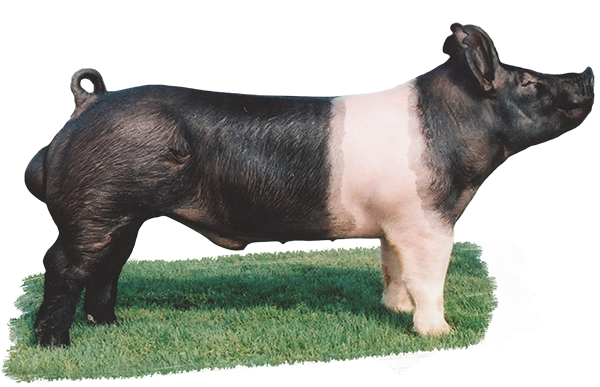
When used as a terminal sire, Hampshires offer the most effective method to increase primal yield, which leads to an increased premium in packer grids. When incorporated into a commercial sow base. Hampshires have a proven record of increased durability and robustness, while contributing to superior carcass composition of the commercial market hog.
Updated by the board of directors of the Hampshire Swine Registry – March, 2016
For a printable version of these requirements click the button below:
Hampshire hogs are black with a white belt. They have erect ears. The belt is a strip of white across the shoulders that covers the front legs around the body. The Hampshire, which is a heavily muscled, lean meat breed, is the fourth most recorded breed of the pigs in the United States.
The Hampshire breed is possibly the oldest, early-American breed of hogs in existence today. The Hampshire hog as we know it today, originated in southern Scotland and Northern England. These pigs were known as the "Old English Breed". They were noted and criticized for their large size, as pigs were commonly killed at 125 pounds liveweight. However, they were admired for their proficiency, hardy vigor, foraging ability and outstanding carcass qualities.
Hampshire pigs were imported into America between 1825 and 1835 from Hampshire County in England. Some of the first importations were also known as the McKay hog because a man by that name was thought to have imported these hogs from England to America.
Most of the offspring of these early importations went to Kentucky where the breed had most of its early development. The common name for these hogs were "Thin Rinds" because their skin was thinner than that of most hogs. The hogs in this area became rather popular due to their hardiness, vigor, prolificacy and foraging characteristics. Butchers from Ohio traveled yearly into Kentucky to contract ahead for these belted hogs at a premium price. These original desirable traits have been further developed within the Hampshire breed, causing steady growth in popularity and demand.
In May of 1893, a small group of Kentucky farmers met in Erlanger, Ky., to form the first record association in order to keep the blood pure in these black hogs with a white belt. The first record association was called the American Thin Rind Association.
This belted hog had various other names in those days, including McGee hog, McKay, Saddleback and Ring Middle. Because this hog was known by so many different names, the name was changed in 1904 to the American Hampshire Record Association.
In 1907, the organization in Kentucky was discontinued. At that time, they adopted American Hampshire Swine Record Association as their name. The name was shortened to Hampshire Swine Record Association in 1922 and in 1939, the name Hampshire Swine Registry was adopted.
Between 1910 and 1920, Hampshires were a big hit in the Corn Belt. During the 1920's the breed continued to grow in numbers and in favor. The greatest popularity of the Hampshires did not come until after 1930. Since that time they have been very popular and have sold for high prices, as their genetic value has been documented.
Through the years, Hampshires that are still being produced, are productive, lean,durable, profitable, and popular on dinner tables. They are the leader in lean muscle with good carcass quality, minimal amounts of backfat and large loin eyes. Boars are more aggressive now than in recent years. Hampshire females have gained a reputation among many commercial hogmen as great mothers. These females are excellent pig raisers and have extra longevity in the sow herd. They have passed the test in confinement.
This black animal with the distinct and unique white belt is still known universally as "The Mark of a Meat Hog". Their ability to sire winning carcasses is unequalled and they continue to set the standard by which all other terminal sires are evaluated.



